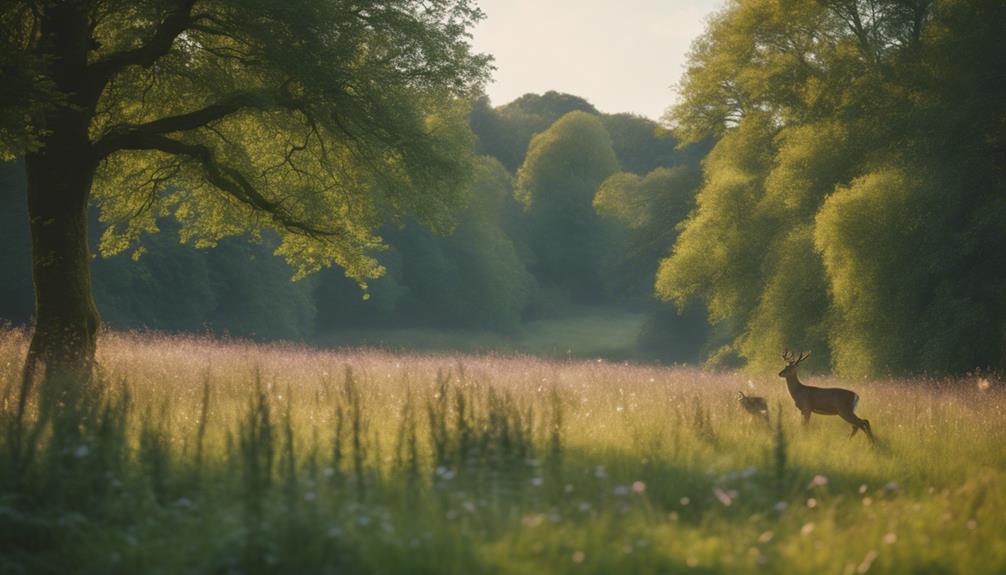Top Wildlife Photography Spots in Shropshire: 10 Tips
Shropshire offers excellent wildlife photography spots, such as Carding Mill Valley and Stiperstones Nature Reserve. Understand your camera settings, especially ISO, aperture, and shutter speed. Always pack essential gear like a telephoto lens and spare batteries. Monitor weather conditions to prepare for sudden changes. Scout locations ahead of time for ideal lighting and habitats. Aim to shoot during dawn or dusk for the best light. Observe animal behaviour to predict movements and capture natural moments. Explore birdwatching sites like RSPB Lake Vyrnwy. Using these tips, you're ready to capture Shropshire's wildlife beautifully—there's more to uncover.
Key Points to Note
- Visit Carding Mill Valley for a variety of wildlife and stunning landscapes during the golden hour.
- Explore RSPB Lake Vyrnwy for excellent birdwatching and diverse bird species in their natural habitats.
- Scout Stiperstones Nature Reserve for unique wildlife and dramatic scenery, perfect for capturing shots at sunrise or sunset.
- Use local guides for tips on the best times and locations to photograph wildlife in Shropshire.
- Remember to pack essential equipment like telephoto lenses and spare batteries for longer wildlife photography sessions.
Understand Your Camera
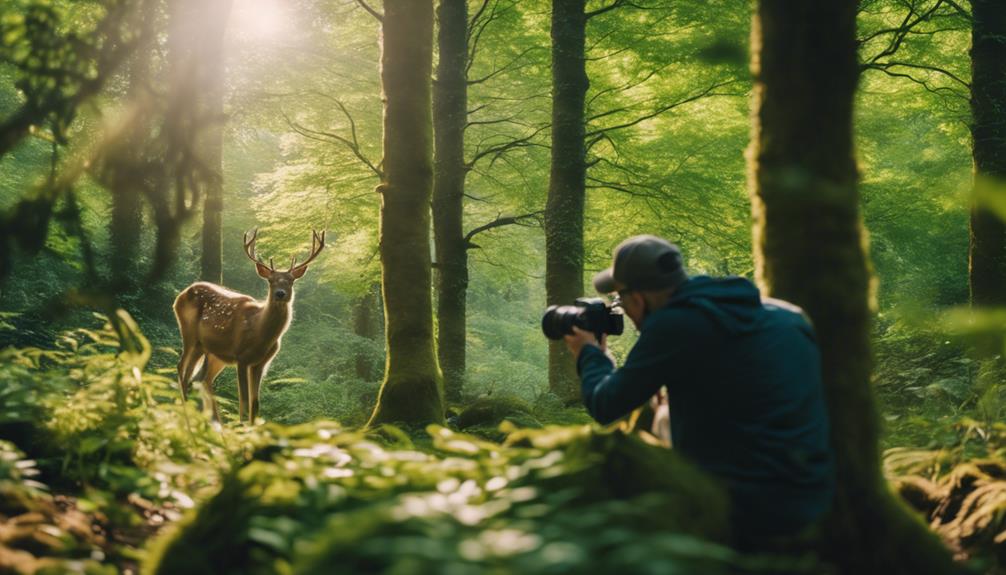
To capture stunning wildlife photos in Shropshire, you need to master your camera settings like ISO, aperture, and shutter speed. Understanding these settings will significantly enhance your shots. Start by practicing patience. Wildlife photography often requires waiting for the perfect moment, and rushing can lead to missed opportunities.
Experiment with different settings to see what works best in various lighting conditions. For example, adjusting the ISO can help you manage low light situations, while altering the aperture can change the depth of field, making your subject stand out more. Shutter speed is essential for freezing fast-moving animals or creating artistic motion blur.
Each camera model, whether DSLR, mirrorless, or point-and-shoot, has unique features. Spend time familiarising yourself with your camera's capabilities. This means reading the manual, watching tutorials, and taking lots of test shots. The more you understand your equipment, the more confident you'll feel in the field.
Pack Essential Equipment
When preparing for wildlife photography in Shropshire, make sure you pack essential gear to handle the unpredictable elements and capture the perfect shot. Start with a waterproof camera cover to protect your equipment from sudden rain.
A sturdy tripod is vital for stability and sharp images, especially in low light.
Next, consider investing in a telephoto lens. It allows you to capture wildlife from a safe distance without disturbing them. Don't forget to bring spare batteries and memory cards. Running out of power or storage space could mean missing out on incredible shots.
Gear organisation is key. Use a camera backpack with easy access compartments for quick setup and shooting opportunities. This way, you won't waste precious seconds rummaging around for your gear.
Equipment maintenance is also important. Regularly check your gear for any issues, clean your lens, and make sure your tripod is functioning properly. This helps you avoid technical problems that could ruin a perfect shot.
Monitor Weather Conditions
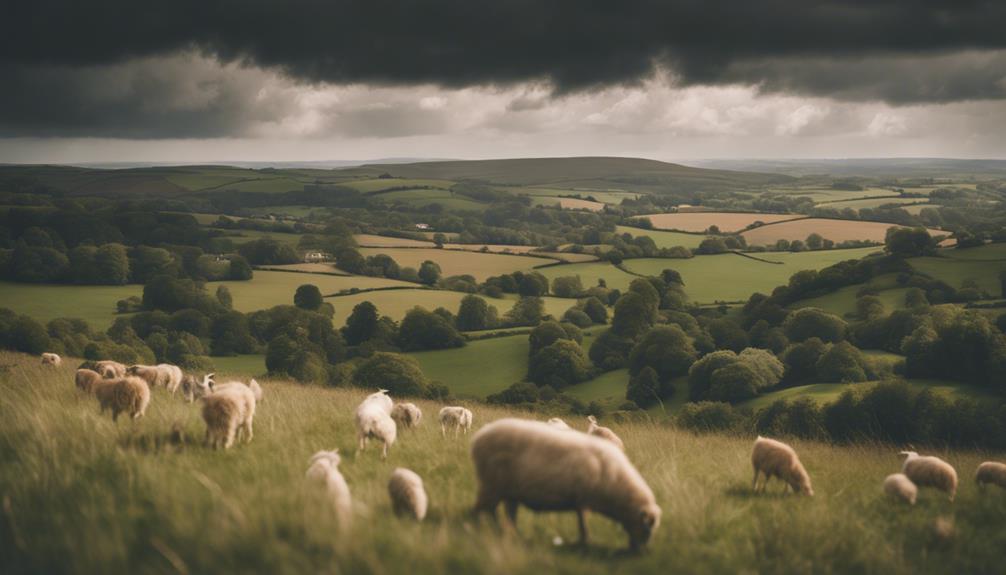
While your gear is ready, monitoring Shropshire's weather conditions guarantees you're prepared for any changes that might impact your wildlife photography. Weather changes can significantly affect your shots, so staying informed is essential.
Using reliable weather apps like Weather Underground or AccuWeather can help you track real-time updates. These apps offer precise forecasts and alerts, which are invaluable wildlife photography tips for ensuring your sessions aren't disrupted by unexpected weather.
One of the wildlife photography gear essentials is having clothing that matches the forecast. Dress in layers to adapt to sudden temperature changes, and don't forget waterproof gear to protect both you and your equipment from rain.
Understanding sunrise and sunset times is also key; ideal lighting conditions occur during these golden hours, enhancing the quality of your photos.
Scout Locations
When scouting locations in Shropshire, begin by researching the optimal times to visit places such as Stiperstones Ridge and Carding Mill Valley, considering lighting and animal activity.
Identify key habitats within these areas, from woodlands to wetlands, to capture a diverse array of wildlife.
Utilize local guides and online resources to efficiently plan your excursions and ensure you maximize your photography opportunities.
Research Best Times
To capture stunning wildlife photos in Shropshire, start by researching the best times around dawn and dusk for ideal lighting conditions. These times not only offer soft, golden light, but also coincide with peak wildlife activity. Understanding seasonal changes and wildlife migration patterns can guide you to the best moments for your photoshoots. For instance, the spring brings migratory birds and new animal births, while autumn showcases stunning foliage and animal preparations for winter.
When scouting locations, use local resources or guides. They can provide invaluable information about prime photography spots and their accessibility.
| Time of Day | Ideal Conditions | Wildlife Behaviour |
|---|---|---|
| Dawn | Soft lighting | High activity, feeding |
| Dusk | Golden hour light | Preparing for night |
| Midday | Harsh shadows | Less active |
Identify Key Habitats
After determining the best times for wildlife activity, you should focus on identifying key habitats to maximise your photographic opportunities in Shropshire. The region boasts diverse habitats like woodlands, farmland, and wetlands, each offering unique chances to capture stunning wildlife diversity.
Start with renowned spots like Shropshire Hills AONB, Stiperstones Ridge, and Wood Lane Nature Reserve. These areas are rich in varied wildlife, making them prime locations for honing your photography techniques. For example, the Shropshire Hills AONB provides expansive views and diverse species, perfect for wide-angle shots and capturing animals in their natural landscapes.
Scout specific locations such as Carding Mill Valley, Mortimer Forest, and Haughmond Hill. Carding Mill Valley is ideal for finding elusive birds, while Mortimer Forest offers dense woodland perfect for photographing larger mammals. Haughmond Hill's mix of habitats supports a range of species, giving you plenty of subjects to practice different photography techniques.
Exploring these habitats not only increases your chances of wildlife encounters but also enriches your photography experience. By identifying and scouting these key locations, you make sure that each outing is productive, allowing you to capture the rich wildlife diversity Shropshire has to offer.
Use Local Guides
Hiring local guides can significantly boost your chances of discovering the best wildlife photography spots in Shropshire. Their local expertise is invaluable when it comes to understanding wildlife behaviour and knowing where to find the most photogenic scenes. These guides often have years of experience and deep knowledge of the area's unique habitats, making them the perfect companions for your photography adventures.
With a local guide, you can scout locations that offer rare species and elusive opportunities. They know the hidden trails and secluded spots where you might capture that perfect shot of a shy otter or a rare bird. Their insights into migration patterns and seasonal behaviour of wildlife can dramatically increase your chances of being in the right place at the right time.
Utilising a local guide doesn't just save you time and effort; it also enriches your experience. You'll learn about the intricate details of Shropshire's ecosystems and gain a deeper appreciation for the wildlife you photograph. Whether you're a seasoned photographer or a newbie, having a local guide can make your journey more rewarding and your photographs more spectacular.
Optimise Timing
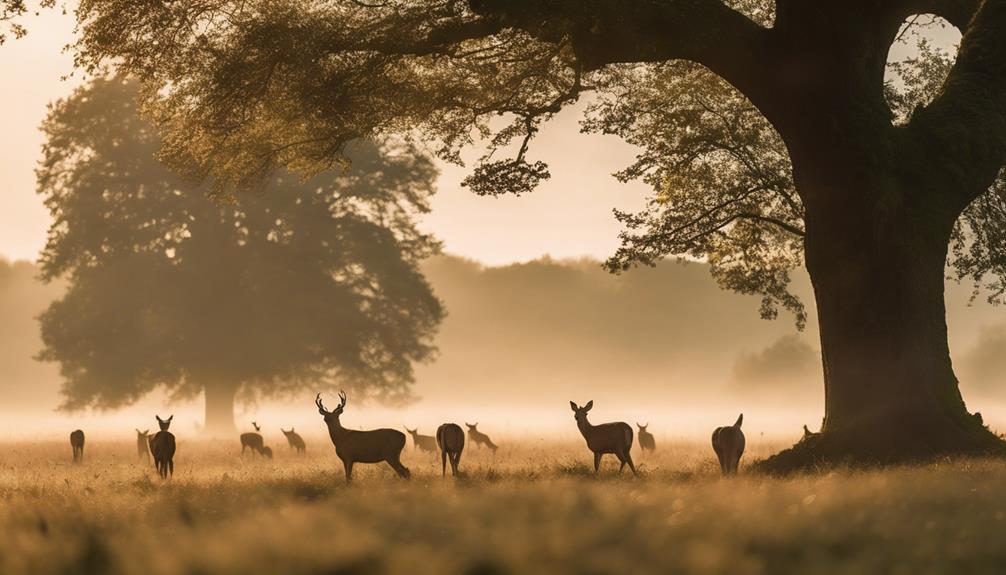
When you aim to capture stunning wildlife photos in Shropshire, timing your shoots around dawn and dusk can make all the difference. These times, known as the golden hours, provide soft, golden lighting that enriches the overall quality of your shots. Adjust your camera settings to take full advantage of these lighting conditions, ensuring that your photos capture the delicate interplay of light and shadow.
During dawn and dusk, wildlife behaviour tends to be more natural and active, offering you a better chance to capture authentic moments. Observe how animals interact with their environment and incorporate these behaviours into your landscape composition. This won't only make your photos more dynamic but also narrate a compelling story about the creatures you're capturing.
Avoid the harsh midday sunlight, which can create unflattering shadows and wash out colours. Instead, plan your outdoor shoots during sunrise and sunset when the sky is painted with stunning colours and contrast. Remember to consider the direction of light to create visually appealing wildlife images.
Utilise Natural Light
You'll find that natural light during golden hours around sunrise and sunset provides soft, warm tones perfect for capturing wildlife.
On overcast days, use the diffused light to minimise harsh shadows and achieve even lighting on your subjects.
Avoid direct harsh sunlight, as it can cause overexposure and high contrast in your photos.
Golden Hour Advantage
Capturing wildlife during the golden hour in Shropshire gifts you with soft, warm light that enriches both colours and textures in your photos. This magical time, around sunrise and sunset, transforms your images, making them vibrant and full of life.
You'll find that wildlife interactions are more engaging, allowing for artistic compositions that tell a story. This is where golden hour storytelling shines, creating wildlife portraits that aren't only beautiful but also deeply evocative.
The natural light during the golden hour magnifies the details in your subjects, highlighting fur, feathers, and foliage in a way that artificial light can't replicate. It's an ideal time to observe and photograph wildlife when they're most active, giving you more opportunities to capture those perfect moments.
Whether it's a deer grazing in a meadow or birds taking flight, the golden hour provides a serene backdrop that enhances your photography.
Avoid Strong Shadows
To enhance the texture and detail in your wildlife photography, make use of the natural light available around sunrise or sunset. This time of day provides a softer, more diffused light that helps reduce wildlife shadows, adding an artistic touch to your images. By positioning yourself with the light source behind you, your subjects will be well-illuminated, and shadows will be less prominent.
Consider the angle of the light for more flattering wildlife portraits. When the light is low and angled, it creates softer shadows that enhance texture and detail without overshadowing them. Harsh shadows can detract from the intricate details in your subject's fur or feathers, affecting the overall quality of your photograph.
Here are a few tips to help you avoid harsh shadows:
- Position yourself with the light source behind you: This ensures your subject is well-lit and reduces shadows.
- Experiment with different lighting conditions: Sunrise and sunset offer unique lighting opportunities for capturing stunning wildlife portraits.
- Pay attention to the direction of the light: Adjust your angle to achieve the desired effect and create softer shadows.
Observe Animal Behaviour
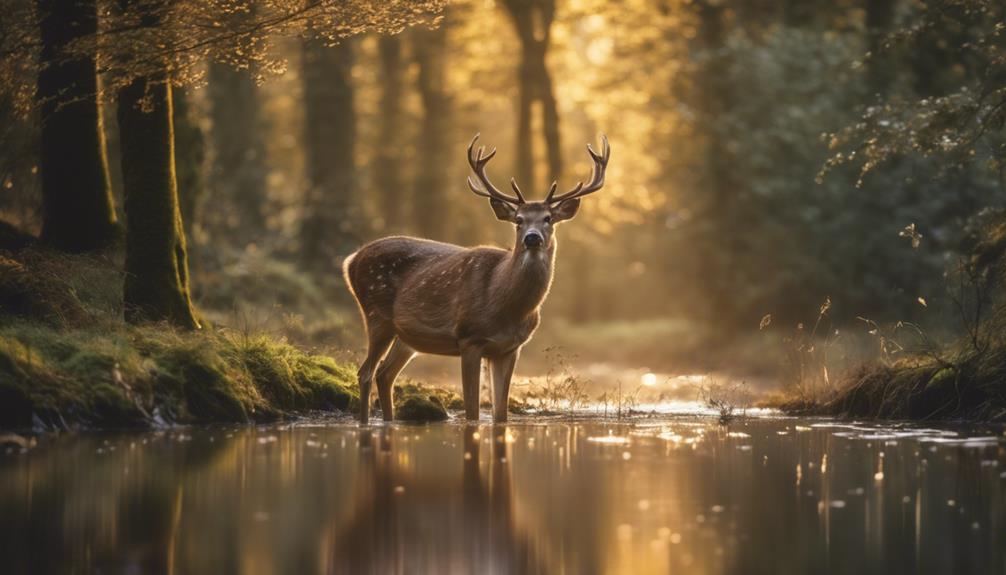
Observing animal behaviour allows you to capture natural and authentic moments in wildlife photography. By paying attention to animal interactions and behavioural cues, you're able to predict movements and anticipate the perfect photo opportunities. This deepens your connection with wildlife, making you feel like part of their world.
Engaging in wildlife observation, you'll find that patience is key. Spend time watching how animals interact with each other and their environment. This isn't just about snapping a quick photo; it's about understanding their routines and habits. Whether it's a deer grazing in a meadow or a family of otters playing by the river, these moments are fleeting and require your full attention.
Here are some photography tips:
Always keep your camera ready and your eyes peeled for sudden changes in behaviour. These shifts can indicate something interesting is about to happen.
When you capture these unique moments, your photographs will tell a compelling story, making them more dynamic and engaging.
Focus on Birdlife
While understanding animal behaviour is vital, focusing on birdlife in Shropshire opens up a whole new world of photographic opportunities. Shropshire is home to some incredible birdwatching spots where you can hone your bird identification skills and contribute to conservation efforts.
At RSPB Lake Vyrnwy, you're in for a treat with its 5-star rating and family-friendly activities. This spot is ideal for capturing various bird species in their natural habitat.
Wood Lane Nature Reserve is another gem, attracting wildfowl enthusiasts with its stunning array of birdlife. Here, you can practice identifying different wildfowl while enjoying the serene environment.
If you're interested in falconry, the Battlefield Bird of Prey Centre is a must-visit. It offers hands-on experiences with local birds of prey, making it easier to photograph them up close and learn about ongoing conservation efforts.
And don't miss Shropshire Falconry Ltd, offering woodland walks and flying opportunities for all ages, rated 5 stars by bird enthusiasts.
Explore Various Habitats
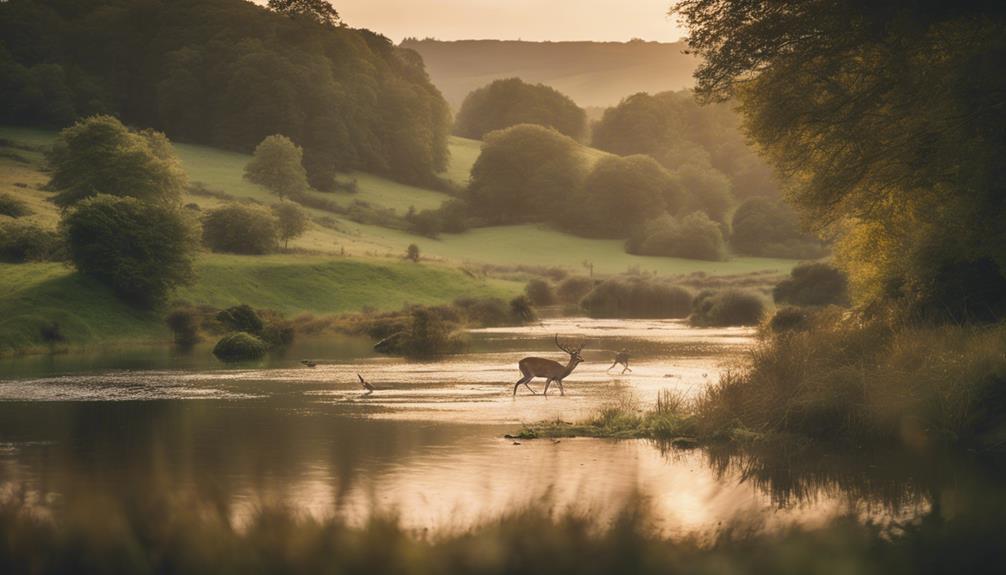
When exploring Shropshire, you'll find a variety of habitats ideal for wildlife photography. Stroll through forests and woodlands to capture birds and woodland creatures, or visit rivers and wetlands where wildfowl and water-based wildlife can be found.
For a change of scenery, the meadows and grasslands provide picturesque rural landscapes and agricultural wildlife to photograph.
Forests and Woodlands
In Shropshire, woodlands like Apley Woods and Mortimer Forest offer fantastic opportunities to capture a wide range of wildlife in their natural habitats. These woodlands provide tranquil settings where you can photograph birds, mammals, and insects as they go about their daily lives. Strolling through these forests, you'll find nature trails leading to hidden gems, perfect for capturing that elusive shot.
Exploring these areas during different seasons adds another dimension to your photography. The seasonal beauty, especially the autumn colours, transforms the forest into a vibrant canvas, making your pictures even more captivating. Woodlands like Haughmond Hill also offer unique perspectives, thanks to their diverse flora and fauna.
When you're out there, be prepared for varying light conditions. Dense canopies can create challenging shadows, but they also offer opportunities for stunning, filtered light shots. Make sure your gear is ready to adapt.
Here are some tips to get the most out of your forest and woodland photography:
- Bring a tripod: To stabilise your shots in low light.
- Use a telephoto lens: To capture distant wildlife without disturbing them.
- Plan your visit: Knowing the best times for different animal activities.
Exploring Shropshire's woodlands isn't just about photography; it's about connecting with nature and finding your place within it.
Rivers and Wetlands
Shropshire's rivers and wetlands attract wildlife photographers with their rich habitats and diverse species. These wetland ecosystems are perfect for birdwatching and capturing the dynamic life of waterfowl and other aquatic creatures. A must-visit is the Wood Lane Nature Reserve, where you can immerse yourself in birdwatching and wetland photography opportunities. The sight of various bird species against the serene backdrop of the wetlands is truly a photographer's delight.
Rivers like the Severn and Tern offer picturesque river landscapes that are ideal for wildlife photography. As you wander along their banks, you'll find countless opportunities to photograph animals in their natural habitat. The tranquil beauty of these rivers elevates your shots, providing a peaceful setting that brings the wildlife into focus.
The diversity of species drawn to Shropshire's wetlands means you'll never run out of subjects to capture. Whether it's a heron standing majestically in the water or a flock of ducks gliding across the surface, these wetlands offer unique and rewarding photography experiences.
Meadows and Grasslands
Beyond the rivers and wetlands, Shropshire's meadows and grasslands offer equally enticing opportunities for wildlife photography. These habitats are brimming with life, giving you a chance to capture diverse and fascinating subjects.
In the wildflower fields, you can focus on macro photography, capturing the intricate details of blossoms, butterflies, and bees. These close-up shots reveal a hidden world that is often overlooked.
Grassland panoramas, on the other hand, are perfect for wide-angle shots. These open spaces are home to birds, insects, and larger mammals like deer and foxes. Using a wide-angle lens, you can capture the expansive beauty of these landscapes and the wildlife within them.
Golden hour is an ideal time for shooting in meadows and grasslands. The soft, warm light enhances the natural colours and creates stunning effects. Don't forget to experiment with different camera angles to capture the unique beauty and details of meadow and grassland wildlife.
- Explore the wildflower fields for intricate macro photography.
- Capture expansive grassland panoramas with wide-angle shots.
- Take advantage of golden hour for stunning lighting effects.
Shropshire's meadows and grasslands await your creative touch.
Visit Important Locations
Immerse yourself in the heart of Shropshire's natural beauty by exploring popular wildlife photography spots like Carding Mill Valley and Stiperstones Nature Reserve. These areas are perfect for those looking to discover hidden gems and capture rare moments in nature. Bring your camera and be ready to snap shots of the unique landscapes and diverse wildlife that call these places home.
For a chance to photograph birds of prey, visit Shropshire Falconry Ltd. You'll get unique flying opportunities and woodland walks that provide excellent photo backdrops. If exotic animals are your focus, the Exotic Zoo Wildlife Park offers a diverse range of wildlife that's highly rated among enthusiasts. For birdwatching and stunning scenery, RSPB Lake Vyrnwy is your go-to spot. Don't forget Frankly Farm Tours, where you can interact with Alpacas, making it ideal for families and photography enthusiasts alike.
| Location | Highlight |
|---|---|
| Carding Mill Valley | Discover hidden gems, scenic landscapes |
| Stiperstones Nature Reserve | Capture rare moments, unique wildlife |
| Shropshire Falconry Ltd | Birds of prey, woodland walks |
| Exotic Zoo Wildlife Park | Diverse exotic animals |
| RSPB Lake Vyrnwy | Birdwatching, stunning scenery |
| Frankly Farm Tours | Alpaca interactions, family-friendly |
Frequently Asked Questions
Where to Go for Wildlife Photography in the UK?
For unforgettable wildlife photography in the UK, visit coastal reserves like Norfolk Coast or urban wildlife spots like London's Wetland Centre. You'll feel a sense of belonging as you capture diverse, stunning wildlife in these unique locations.
Are the Shropshire Hills Worth Visiting?
Certainly, the Shropshire Hills are worth a visit! You'll adore the walking paths and picturesque views. It's an ideal location to immerse yourself in nature, discover a variety of wildlife, and be a part of a friendly community.
Conclusion
By following these tips, you'll be well-prepared to capture stunning wildlife photos in Shropshire. Understand your camera's settings, pack the right gear, and keep an eye on the weather.
Scout out locations and optimise your timing for the best shots. Observe animal behaviour closely, pay attention to birdlife, and explore various habitats. Visit key spots to maximise your chances of success.
With patience and practice, you'll soon have an impressive collection of wildlife photographs.
